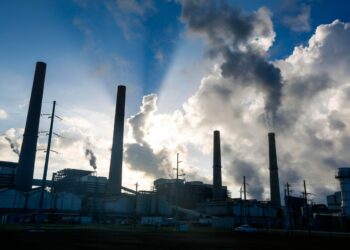With gasoline and diesel hitting record prices amid a post-pandemic surge in driving and flying, it’s no surprise that smart guys like Warren Buffett have been loading up on shares of some of the world’s biggest energy companies including Chevron and Occidentals Petroleum. Giant profits are a welcome turnaround for Big Oil, after the 2020 pandemic lockdowns froze demand and drove oil prices temporarily down to zero. Chevron posted first-quarter revenue of $54.4 billion, 75% higher than a year ago, thanks to surging oil and gas prices. Its shares are up 50% in a year. And consider Saudi Arabian Oil Company; the world’s second-biggest by market value (after Apple) is also the most profitable, scoring $105 billion last year. Energy companies were big movers on this year’s Forbes Global 2000 list, with many jumping more than 300 points in overall rankings.
Despite the profit boom, this is a high-stress time for oil giants. President Vladimir Putin’s invasion of Ukraine is turning the energy markets upside down, with a strong likelihood of crippling fuel shortages as sanctions take hold and Russian oil and natural gas find few buyers. To replace Russia, the world will need every molecule of hydrocarbons the energy giants can extract.
Already the G-7 richest nations have pledged to embargo Russian oil, while sanctions are expected to keep 3 million barrels per day off the market by the end of May. That’s a lot, even in a 100 million bpd global oil market, and especially when pent-up post-pandemic demand for driving and flying had already tightened up fuel supplies before the invasion.
Helping to obscure supply shortfalls, the current round of draconian Covid-19 lockdowns have cut China’s oil demand by an estimated 2 million bpd. When China bounces back, brace for gasoline prices even higher than the $4.25 a gallon now prevalent nationwide. One wild card is how much Russian oil will China continue to buy?
Matt Stephani, president of Cavanal Hill Funds in Tulsa, Oklahoma sees long-term problems for Russia’s oilpatch. “Even if there’s a near-term truce I think it will be a long time before the west wants to buy those Russian barrels back.” Although Russia’s Rosneft, Lukoil and Gazprom scored high on this year’s Global 2000, that’s highly unlikely to last. But the world doesn’t only need to find replacements for Russian oil, but also for Russian gas. Before the war, state-controlled Gazprom was delivering about 15 billion cubic feet of gas per day into Europe, more than a third of total supply, and vital for fueling power plants, and making plastics and fertilizers. But following Putin’s atrocities in Ukraine, Europe is scouring the globe for alternative supplies, in the form of giant tankers of liquefied natural gas, or LNG.
There’s unlikely to be enough. The CEO of Shell, Ben van Beurden said in early May that he was concerned about fuel shortages in Europe next winter. “It will be a tough winter if we don’t get any Russian molecules coming. That’s the only thing I can say with certainty.”
Shortages bring high prices, which mean big profits for oil companies. Yet after their near-death experience in 2020 — when lockdowns dried up demand for transportation fuel and oil prices went to zero — many companies are now being far more careful about how they invest capital. The ongoing ESG (environment, social, and governance) trend continues to discourage energy giants from investing in fossil fuels at all. Consultancy WoodMackenzie says annual oil and gas spending has dropped from $750 billion per year a decade ago to just $400 billion a year more recently.
Rather than plow profits back into drilling and fracking lots of new wells, companies have slowed the growth and are mostly just drilling to maintain their existing levels of output. Even for the biggest operators, growth is increasingly expensive. Billionaire fracking pioneer Harold Hamm of Continental Resources said recently that the costs of drilling wells has inflated by 15%. Even Saudi Aramco, with the biggest reserves, says it would cost $50 billion of investment over several years to add 1 million barrels per day of new oil production to their current 12 million bpd.
After relegating oil companies to purgatory for the past few years, there are even indications that ESG-focused investors are now finding some positive attributes in Big Oil. Jeff Nichols, partner and head of the energy practice at Haynes & Boone says that ESG is evolving to better appreciate the boon to the civilization of reliable energy. “Since Russia’s invasion of Ukraine, concepts like ‘energy security’ and ‘conflict-free oil’ have entered the ESG lexicon.”
Warren Buffett is comfortable with Big Oil. In the first quarter, Berkshire Hathaway added $20 billion worth of Chevron and bought $6.9 billion worth of stock in Occidental Petroleum. Berkshire also holds $10 billion in Oxy preferred stock and a warrant to buy 83.9 million shares at $59.60. It’s almost in the money. Oxy recently traded as high as $58.75. Even after oil’s run-up, Buffett thinks there’s still juice left to squeeze.











